Continue reading for our analysis...
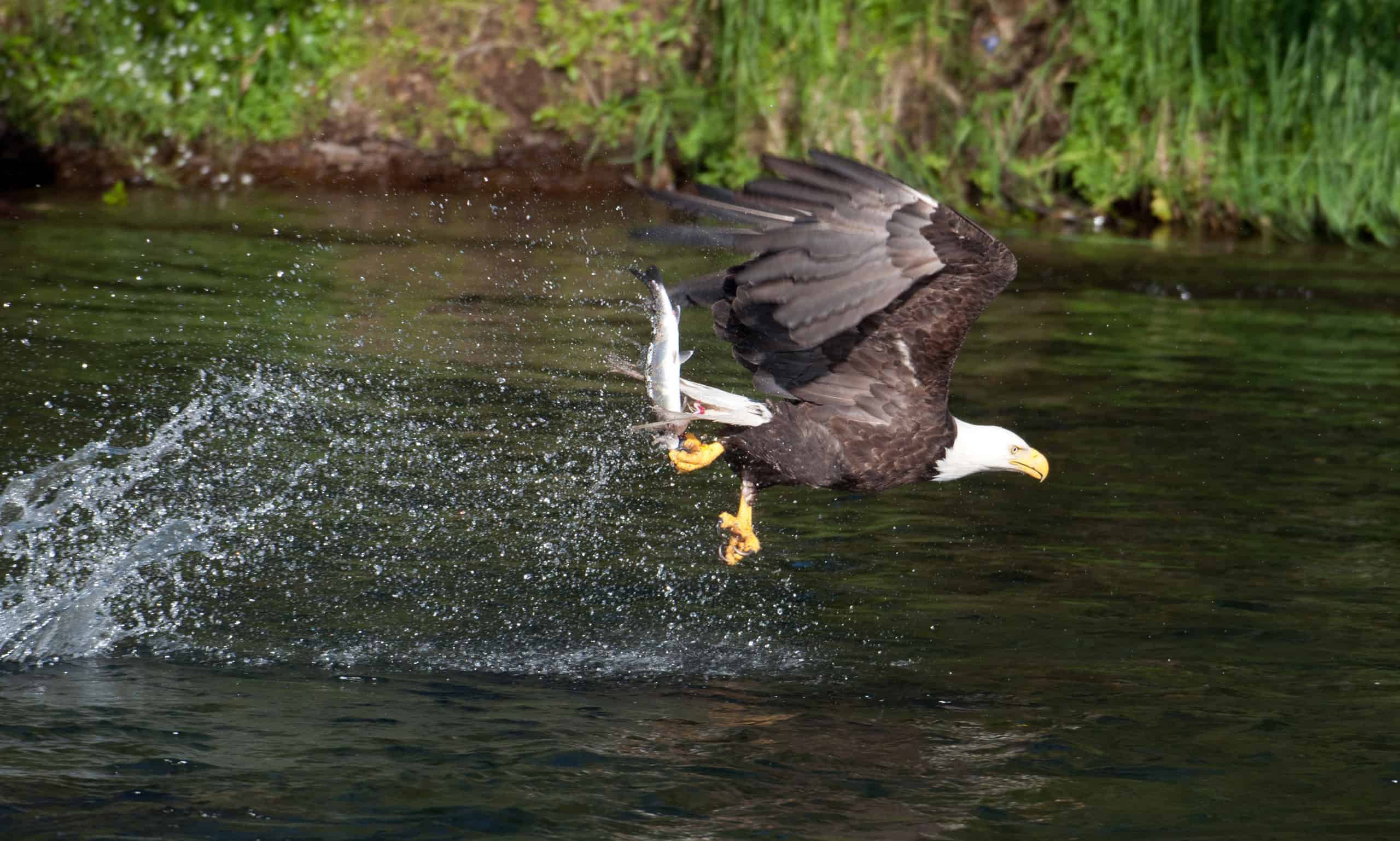
Birds are the most beautiful creatures to watch, especially soaring up in the sky. Bald eagles are no exception. Their hunting skills are something you don’t want to miss watching. They spot their prey from miles away in the sky thanks to their remarkable eyesight. They have a 3- to 4-fold sharper vision than humans, and their overlapped sight gives them a wonderful sense of depth.
This video shows a bald eagle catching a salmon and flying away. The eagle is an apex predator, meaning it’s at the top of the food chain and can hunt anything without being preyed upon.
Now, it’s time to see this majestic and remarkably efficient hunter in action. Watch as the bald eagle takes off from its tree perch, swoops down, and extends its talons precisely to snatch the salmon straight out of the water!
Eagles hunt a wide variety of prey, including fish, waterfowl, small mammals, and carrion. Like this video, they’re most often seen fishing for salmon in rivers or lakes.
Bald eagles have a variety of hunting techniques, including aerial pursuit and ambush. They will perch on high branches or cliffs overlooking bodies of water and wait for an opportunity to strike. They swoop down and dive into the water to grab their meal when they spot prey. After they have caught their prey, they will return to their nest, where they eat their food.
What Makes Bald Eagles Great Hunters?
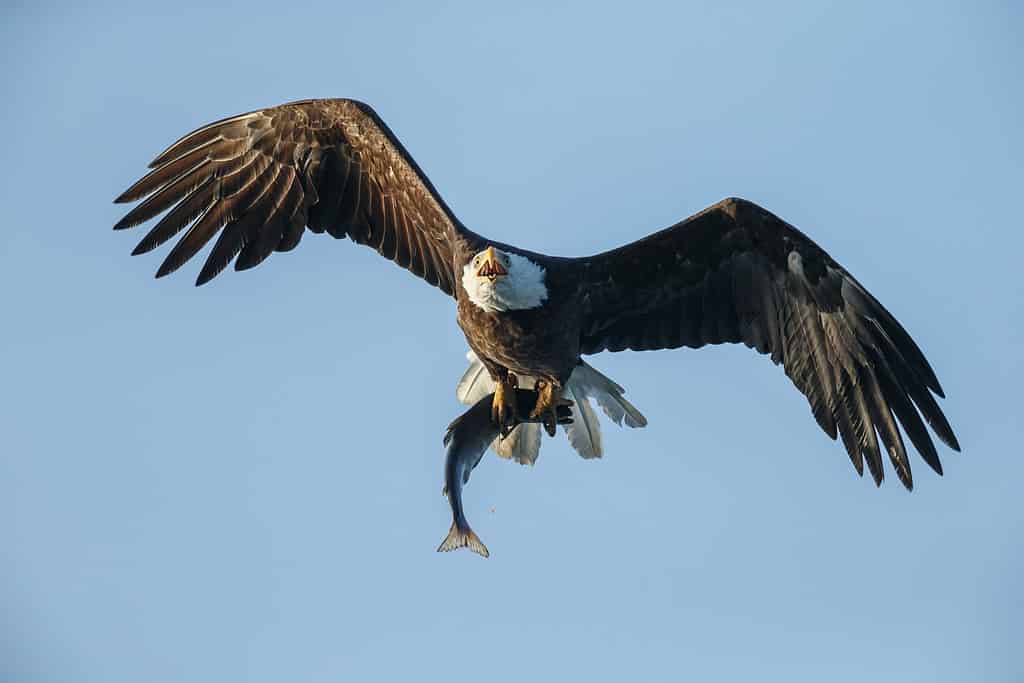
Like this video shows, bald eagles are most often seen fishing for salmon in rivers or lakes.
©iStock.com/Schaef1
Eagles are one of the most majestic and powerful birds in the world. They can soar through the air, dive into the water, and even snatch prey from the ground. But what makes them such great hunters?
Eagles have a few unique adaptations that help them hunt their prey, including excellent vision and hearing, sharp talons, and strong beaks. They also have exceptional flying abilities and can soar for long periods without flapping their wings.
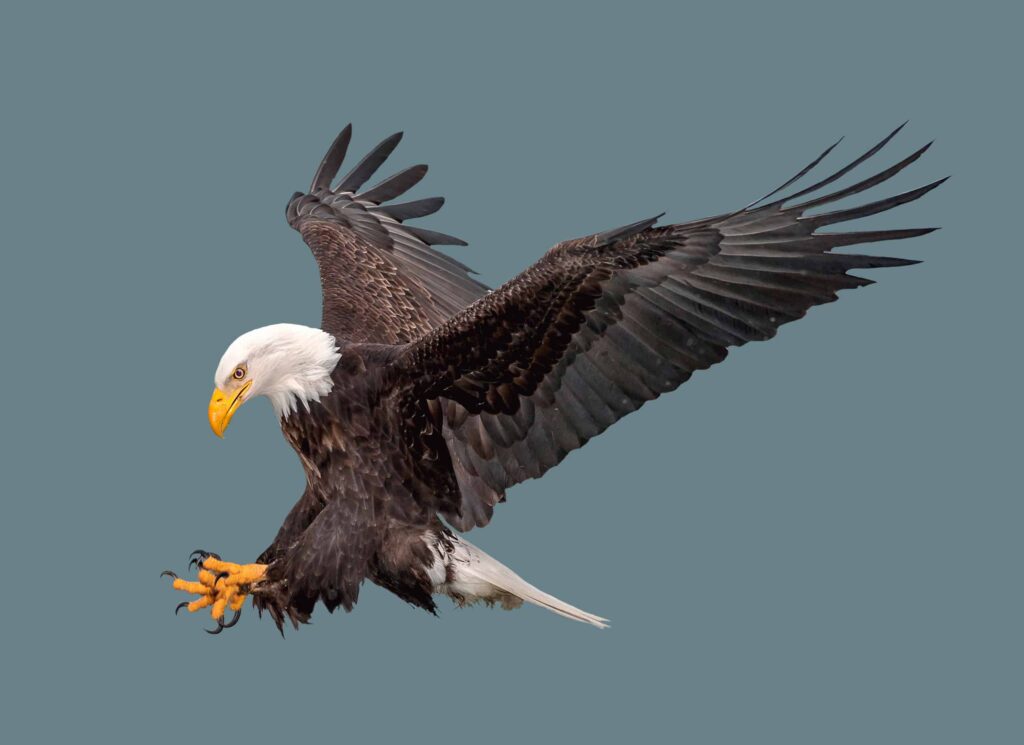
Eagles are extremely agile and powerful.
©PHOTOOBJECT/Shutterstock.com
- Excellent vision and hearing: Eagles can see as far as 3 miles away and hear sounds up to 5 miles away. These senses help eagles locate prey from a distance. It also allows them to see predators before they come too close. This helps protect the birds from attack while hunting or roosting in trees at night.
- Sharp talons and strong beaks: Eagle nails are strong enough to catch large prey like deer, fish, or rabbits. Their beaks are designed for tearing meat off carcasses. Eagles use their powerful feet to hold onto their prey while they tear off chunks with their beaks.
- Eagles are fast, agile, and strong. Their massive wingspan allows them to soar at high altitudes while they scan their surroundings for prey. Their powerful paws enable them to quickly grab their prey from almost any angle and even lift small animals like squirrels in flight.
- Sturdy feathers: Eagles’ feathers are stiff and sturdy, so they don’t get bent or broken when they land on branches or rocks. This makes it easier for them to land safely after catching prey midair or diving into the water at high speeds.
Many have crowned this very successful predator the pinnacle of bird hunting prowess. It can accomplish a feat that few birds are capable of. The bald eagle has no natural predators and continues to thrive in today’s world.
How Likely Are Bald Eagles to Enjoy a Successful Hunt?
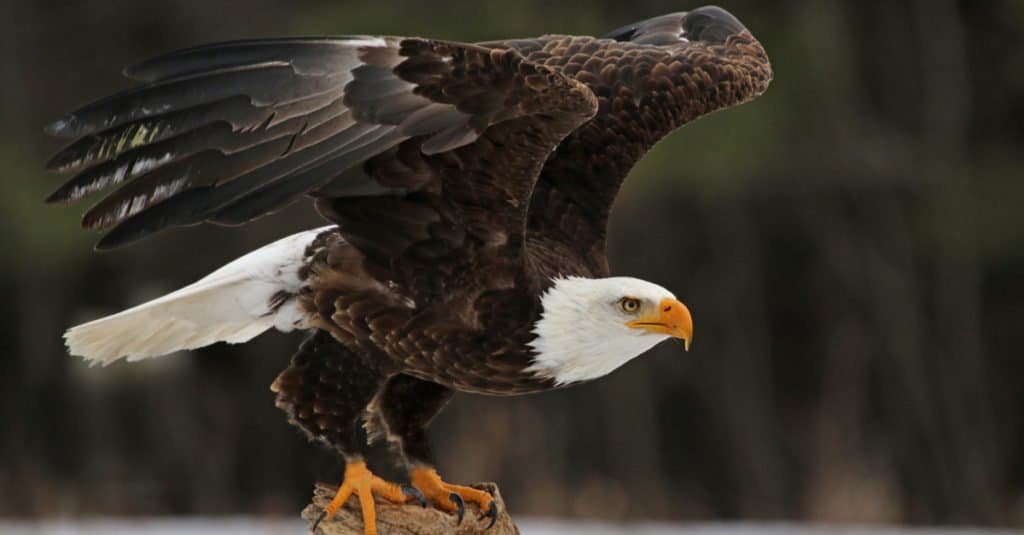
Bald eagels are skilled at hunting and at theft, too.
©Chris Hill/Shutterstock.com
It depends on the prey being hunted. Waterfowl are likely to spot the swooping raptor and take off before it gets up close with those dangerous claws.
However, as we can see from the video below, salmon is a rather different affair. Researchers observing the avian during winter in Nebraska noted that its chances of success were 24%.
It also worth noting that bald eagles are also fond of pilfering, and will help themselves to another eagle’s dinner where possible.
Where Do Bald Eagles Live?
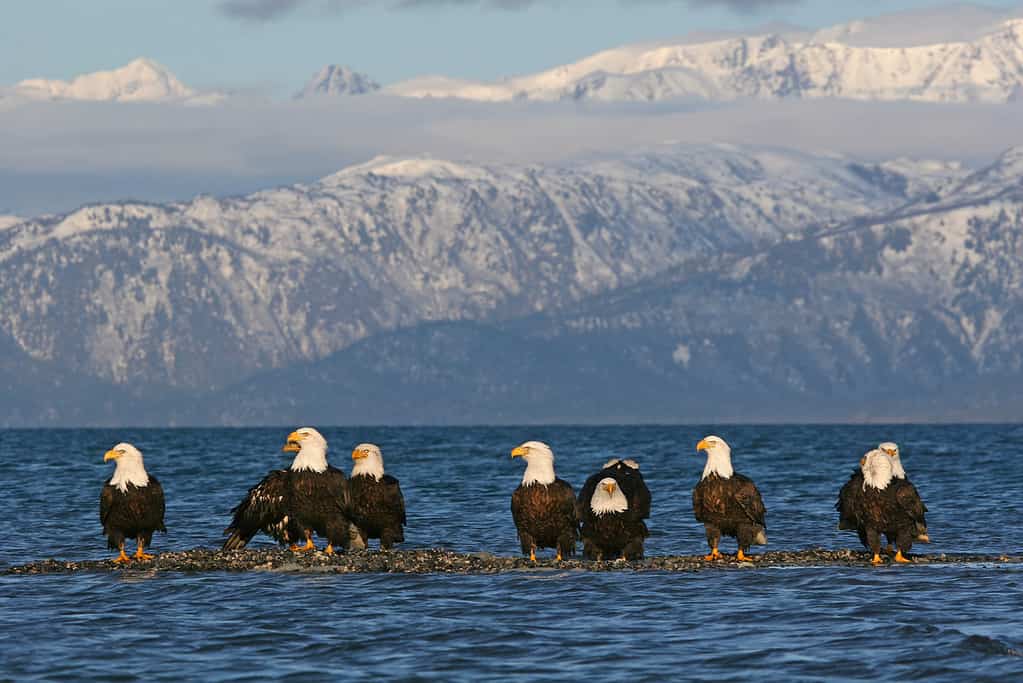
Bald eagles’ range is as north as Alaska and as south as Mexico.
©iStock.com/Silfox
The bald eagle is native to North America and can be found as far north as Alaska and Northern Canada and south all the way down to Mexico. Although it’s been reported that the species has been sighted in Belize, Bermuda, and the Arctic.
Alaska is home to more than half of all the bald eagles in the world. There are around 20,000 bald eagles each in British Columbia and Mexico.
They generally live near the coasts and mature forests with a large body of water nearby, such as an estuary, river, or lake, supplying a food source. The Alaskan salmon run is the main reason why there are so many of these birds in the state — and salmon definitely provides a tasty meal for the bird in this video we’re featuring.
Bald eagles are territorial and will protect their territory from other eagles looking for food. They will also defend their territory from other predators like wolves and cougars.
How Long Do Bald Eagles Live?
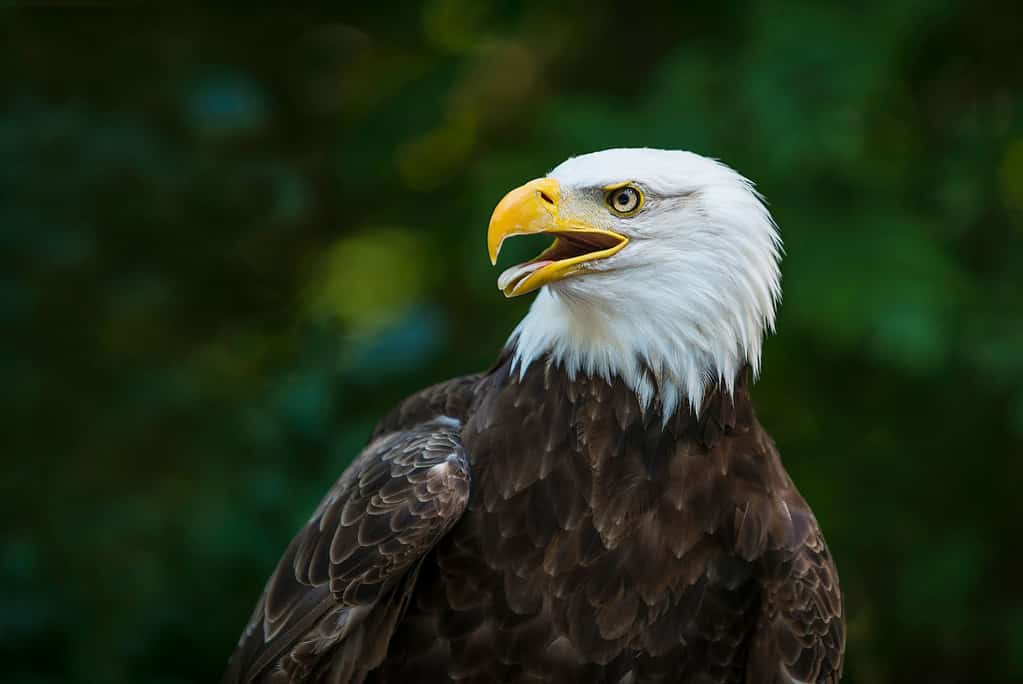
A bald eagle’s average lifespan in the wild is 20-30 years. In captivity, they can live up to 50 years.
©iStock.com/hsun337 – License
Because they are apex predators in their territory, bald eagles have an unusually long lifespan compared to other bird species. On average, a bald eagle’s lifespan in the wild is 20-30 years. In captivity, they can live much longer, up to 50 years. The oldest bald eagle on record in the wild lived to be 38 years old.
The biggest factor that may affect how long they live is habitat loss caused by humans, especially as the development of beachfront properties reduces the land near the water bodies and limits access to its aquatic food supply. Other factors include the risk of electrocution while they perch on power lines and a lack of viable nesting sites due to the destruction of pine trees by people.
The bald eagle’s lifespan is shorter than other eagles. Typically, eagle species such as the harpy eagle have been found to live between 25-35 years in the wild.
Bald Eagle vs. Golden Eagle
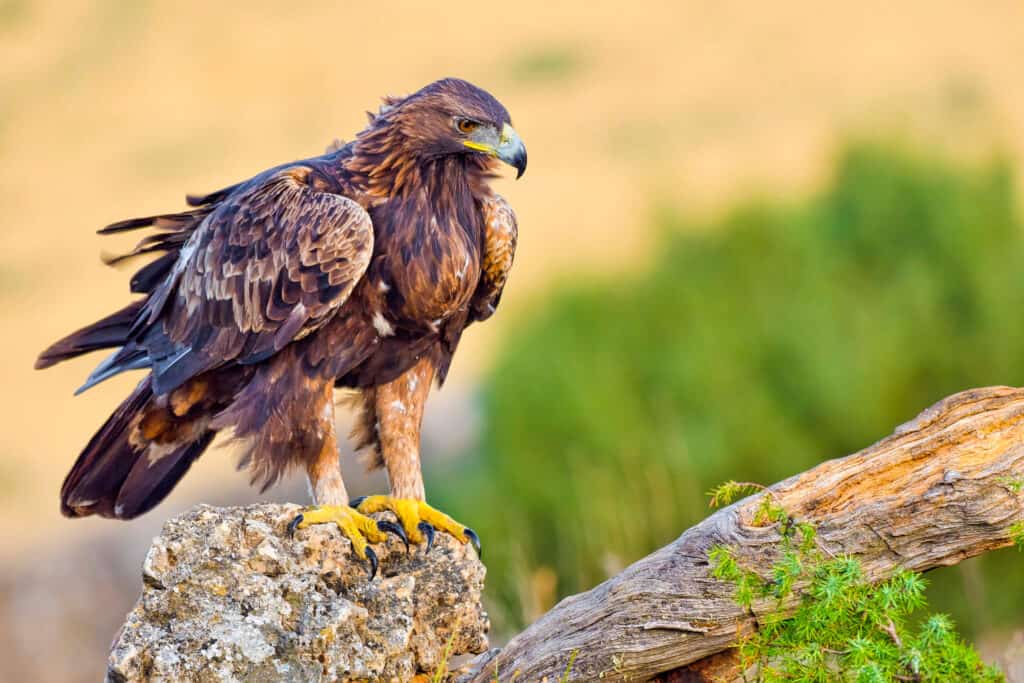
Golden eagles differ from bald eagles as they mature when feathers around their necks begin to be golden-brown.
©Al Carrera/Shutterstock.com
Is the bird below a bald eagle or a golden eagle? As it’s mature, we can tell it’s a bald eagle, but it’s true that the bald eagle can sometimes be confused with the golden eagle especially when young as they are similar in their appearance when it comes to size and color. However, there are a few ways to tell these birds apart.
A key difference between the two is their taxonomy. While the bald eagle belongs to the genus Haliaeetus (commonly called sea eagles) and its closest relatives are the kite bird species, the golden eagle is from the genus Aquila and is more closely related to raptors in the hawk family.
While they both start out with dark brown plumage with white markings on their wings and tails, as these birds mature it’s easier to identify each species. The golden eagle’s feathers around its neck begin to be golden-brown, revealing the source of their name, and the bald eagle gains its distinctive white hood.
The two species also live in different habitats. Unlike bald eagles who like wetlands and heavily forested areas with old-growth trees, golden eagles stay away from dense forests as well as overly developed regions and generally prefer areas that are rocky, open plains with a lot of cliffs. To find out more ways to differentiate a bald eagle from a golden eagle go here.
Thank you for reading! Have some feedback for us? Contact the AZ Animals editorial team.






